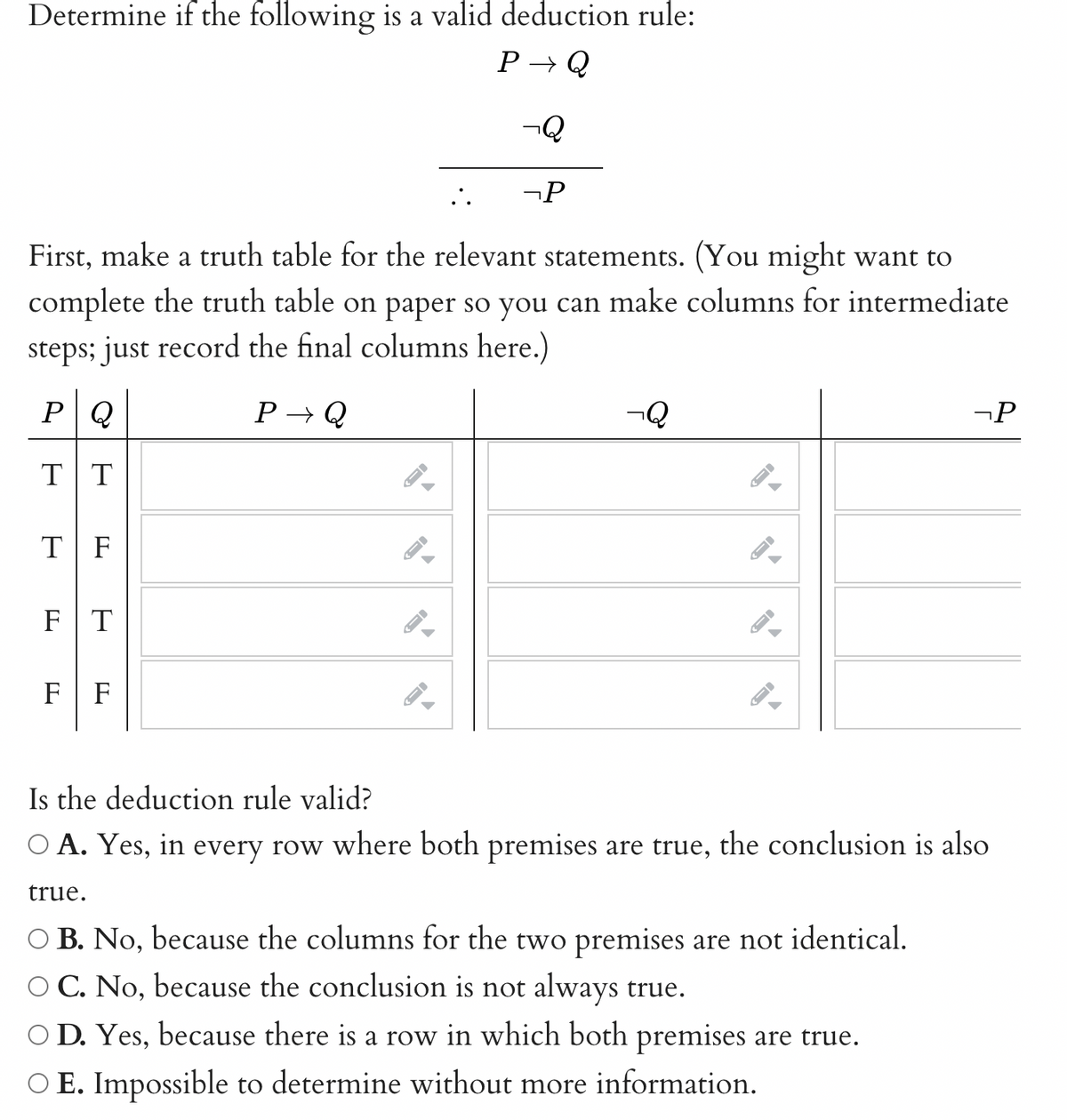Determine if the following is a valid deduction rule: P→ Q -Q TF First, make a truth table for the relevant statements. (You might want to complete the truth table on paper so you can make columns for intermediate steps; just record the final columns here.) PQ P→ Q T|T FT F F A - -> .. -> -P -Q A - -> -> -P Is the deduction rule valid? O A. Yes, in every row where both premises are true, the conclusion is also true. ○ B. No, because the columns for the two premises are not identical. C. No, because the conclusion is not always true. D. Yes, because there is a row in which both premises are true. O E. Impossible to determine without more information.
Determine if the following is a valid deduction rule: P→ Q -Q TF First, make a truth table for the relevant statements. (You might want to complete the truth table on paper so you can make columns for intermediate steps; just record the final columns here.) PQ P→ Q T|T FT F F A - -> .. -> -P -Q A - -> -> -P Is the deduction rule valid? O A. Yes, in every row where both premises are true, the conclusion is also true. ○ B. No, because the columns for the two premises are not identical. C. No, because the conclusion is not always true. D. Yes, because there is a row in which both premises are true. O E. Impossible to determine without more information.
Advanced Engineering Mathematics
10th Edition
ISBN:9780470458365
Author:Erwin Kreyszig
Publisher:Erwin Kreyszig
Chapter2: Second-order Linear Odes
Section: Chapter Questions
Problem 1RQ
Related questions
Question

Transcribed Image Text:Determine if the following is a valid deduction rule:
P→ Q
-Q
TF
First, make a truth table for the relevant statements. (You might want to
complete the truth table on paper so you can make columns for intermediate
steps; just record the final columns here.)
PQ
P→ Q
T|T
FT
F F
A
-
->
..
->
-P
-Q
A
-
->
->
-P
Is the deduction rule valid?
O A. Yes, in every row where both premises are true, the conclusion is also
true.
○ B. No, because the columns for the two premises are not identical.
C. No, because the conclusion is not always true.
D. Yes, because there is a row in which both premises are true.
O E. Impossible to determine without more information.
Expert Solution
This question has been solved!
Explore an expertly crafted, step-by-step solution for a thorough understanding of key concepts.
Step by step
Solved in 2 steps

Recommended textbooks for you

Advanced Engineering Mathematics
Advanced Math
ISBN:
9780470458365
Author:
Erwin Kreyszig
Publisher:
Wiley, John & Sons, Incorporated

Numerical Methods for Engineers
Advanced Math
ISBN:
9780073397924
Author:
Steven C. Chapra Dr., Raymond P. Canale
Publisher:
McGraw-Hill Education

Introductory Mathematics for Engineering Applicat…
Advanced Math
ISBN:
9781118141809
Author:
Nathan Klingbeil
Publisher:
WILEY

Advanced Engineering Mathematics
Advanced Math
ISBN:
9780470458365
Author:
Erwin Kreyszig
Publisher:
Wiley, John & Sons, Incorporated

Numerical Methods for Engineers
Advanced Math
ISBN:
9780073397924
Author:
Steven C. Chapra Dr., Raymond P. Canale
Publisher:
McGraw-Hill Education

Introductory Mathematics for Engineering Applicat…
Advanced Math
ISBN:
9781118141809
Author:
Nathan Klingbeil
Publisher:
WILEY

Mathematics For Machine Technology
Advanced Math
ISBN:
9781337798310
Author:
Peterson, John.
Publisher:
Cengage Learning,

